

Anglo-saxon. Wuthering Heights: Comparison between the novel and the 2011 adaptation by producer Andrea Arnold. Turning to Arnold’s characters, Thompson (2012, online) claims that they “bear little resemblance to the originals” .
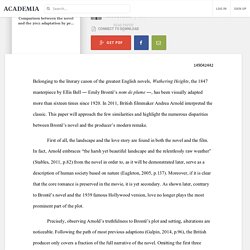
In fact, Hindley’s features change from “being lost in masses of shaggy hair that hung on his shoulders” (Chapter XIII, p. 107) to shaven and Edgar’s light. Anglo-Saxon literature: Poetry. There are two types of Old English poetry: the heroic, the sources of which are pre-Christian Germanic myth, history, and custom; and the Christian.
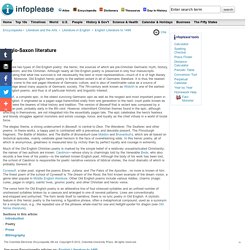
Although nearly all Old English poetry is preserved in only four manuscripts—indicating that what has survived is not necessarily the best or most representative—much of it is of high literary quality. Moreover, Old English heroic poetry is the earliest extant in all of Germanic literature. It is thus the nearest we can come to the oral pagan literature of Germanic culture, and is also of inestimable value as a source of knowledge about many aspects of Germanic society.
The 7th-century work known as Widsith is one of the earliest Old English poems, and thus is of particular historic and linguistic interest. Beowulf, a complete epic, is the oldest surviving Germanic epic as well as the longest and most important poem in Old English. The Columbia Electronic Encyclopedia, 6th ed. See more Encyclopedia articles on: English Literature to 1499. Anglo-Saxon literature: Introduction. Anglo-Saxon Poetry: Characteristics & Examples. In this lesson, we will review the general history of Anglo-Saxon society and its era.

Then, we will look closer at the characteristics of the literature, specifically the poetry, of that era. Explore our library of over 10,000 lessons Click "next lesson" whenever you finish a lesson and quiz. Got It You now have full access to our lessons and courses. You're 25% of the way through this course! Way to go! Congratulations on earning a badge for watching 10 videos but you've only scratched the surface. You've just earned a badge for watching 50 different lessons. You have earned a badge for watching 20 minutes of lessons. You have earned a badge for watching 50 minutes of lessons. You have earned a badge for watching 100 minutes of lessons.
You have earned a badge for watching 250 minutes of lessons. Old English, New Influences. Anglo-Saxon (Old English) literature – of which the best-known example is the epic poem Beowulf – flourished from the sixth century CE until the Norman Conquest.
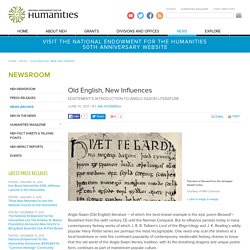
But its influence persists today in many contemporary fantasy works of which J. R. R. Tolkien’s Lord of the Rings trilogy and J. K. EDSITEment's lesson plan for teachers, "The Beauty of Anglo-Saxon Poetry: A Prelude to Beowulf," provides a background for understanding these and similar influences. Exploring the Depth and Beauty of Anglo-Saxon Literature. This map shows kingdoms in the island of Great Britain at about the year 800 CE.
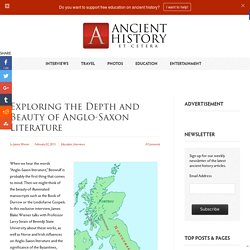
When we hear the words “Anglo-Saxon literature,” Beowulf is probably the first thing that comes to mind. The Anglo-Saxon kings. In the Dark Ages during the fifth and sixth centuries, communities of peoples in Britain inhabited homelands with ill-defined borders.
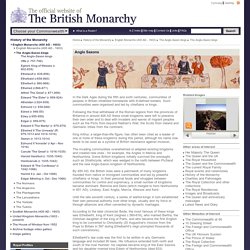
Such communities were organised and led by chieftains or kings. Following the final withdrawal of the Roman legions from the provinces of Britannia in around 408 AD these small kingdoms were left to preserve their own order and to deal with invaders and waves of migrant peoples such as the Picts from beyond Hadrian's Wall, the Scots from Ireland and Germanic tribes from the continent.
King Arthur, a larger-than-life figure, has often been cited as a leader of one or more of these kingdoms during this period, although his name now tends to be used as a symbol of British resistance against invasion. The invading communities overwhelmed or adapted existing kingdoms and created new ones - for example, the Angles in Mercia and Northumbria. Ethelberht's law code was the first to be written in any Germanic language and included 90 laws.
Featured English Monarch. Ethelbert, 1st Christian King of Kent - 601-900 Church History Timeline. The fortunes of Christianity have waxed and waned in Britain.
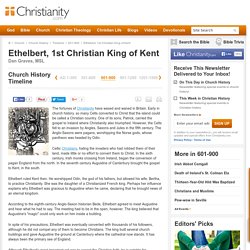
Early in church history, so many Celts converted to Christ that the island could be called a Christian country. One of its sons, Patrick, carried the gospel to Ireland where Christianity also triumphed. However, the Celts fell to an invasion by Angles, Saxons and Jutes in the fifth century. The Anglo-Saxons were pagans, worshipping the Norse gods, whose pantheon was headed by Odin.
Celtic Christians, hating the invaders who had robbed them of their land, made little or no effort to convert them to Christ. Ethelbert ruled Kent then. According to the eighth-century Anglo-Saxon historian Bede, Ethelbert agreed to meet Augustine and hear what he had to say. In spite of his precautions, Ethelbert was eventually converted with thousands of his followers, although he did not compel any of them to become Christians.
On February 24, 616 the king died. Bibliography: "Augustine, St., of Canterbury," and "Ethelbert, St. " History - Ancient History in depth: Overview: Anglo-Saxons, 410 to 800. Invaders! Angles, Saxons and Vikings. The Romans had been troubled by serious barbarian raids since around AD 360.
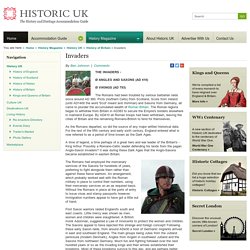
Picts (northern Celts) from Scotland, Scots from Ireland (until AD1400 the word 'Scot' meant and Irishman) and Saxons from Germany, all came to plunder the accumulated wealth of Roman Britain. The Roman legions began to withdraw from Britain in AD383 to secure the Empire's borders elsewhere in mainland Europe.